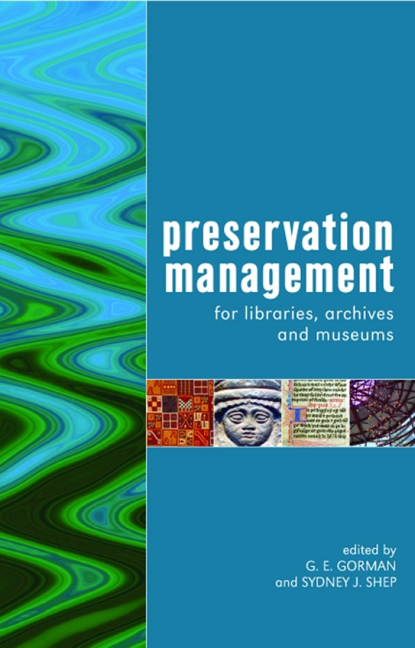Book contents
- Frontmatter
- Contents
- About the contributors
- Introduction
- 1 Managing the documentary heritage: issues for the present and future
- 2 Preservation policy and planning
- 3 Intangible heritage: museums and preservation
- 4 Surrogacy and the artefact
- 5 Moving with the times in search of permanence
- 6 Valuation model for paper conservation research: a new approach for setting research priorities
- 7 Preservation of audiovisual media: traditional to interactive formats
- 8 Challenges of managing the digitally born artefact
- 9 Preserving cultural heritage in times of conflict
- 10 Access and the social contract in memory institutions
- 11 Redefining ‘the collection’ in the 21st century
- Index
3 - Intangible heritage: museums and preservation
Published online by Cambridge University Press: 08 June 2018
- Frontmatter
- Contents
- About the contributors
- Introduction
- 1 Managing the documentary heritage: issues for the present and future
- 2 Preservation policy and planning
- 3 Intangible heritage: museums and preservation
- 4 Surrogacy and the artefact
- 5 Moving with the times in search of permanence
- 6 Valuation model for paper conservation research: a new approach for setting research priorities
- 7 Preservation of audiovisual media: traditional to interactive formats
- 8 Challenges of managing the digitally born artefact
- 9 Preserving cultural heritage in times of conflict
- 10 Access and the social contract in memory institutions
- 11 Redefining ‘the collection’ in the 21st century
- Index
Summary
Introduction
Intangible heritage can have many forms, and the UNESCO Convention on its preservation has made only limited progress so far. The question of whether museums will play a larger role in its preservation is undecided. However, museums already deal with intangible heritage in two main ways. First, museums must consider the inherent intangible aspects of objects, including function or use, religious significance or practice, or artist's intent. Second, museums must consider the preservation of documentation such as written documents, film, photographs, and audio/videotape. This has become particularly important in recent years as the conservation challenges of these ephemeral materials have become more evident. Museums are also increasingly aware of their obligations to aboriginal communities and collections, and must adopt a professional aboriginal approach to the conservation, preservation, and guardianship of tangible and intangible cultural property.
What is intangible heritage?
Culture is not only demonstrated through tangible artefacts but is also manifested through intangible forms, such as language, music, theatre, attitudes, gestures, practices, customs and a whole range of other forms. Intangible heritage includes voices, values, traditions, languages, oral history, folk life, creativity, adaptability and indeed all that is distinctive of a people (International Council of Museums, 2004). This distinctiveness is popularly perceived through cuisine, clothing, forms of shelter, traditional skills and technologies, religious ceremonies, manners, customs, performing arts, storytelling and so forth. Many believe that globalization is a threat to intangible heritage (Galla, 2004), hence there is wide recognition that this form of heritage needs to be safeguarded. Accordingly, in 1993 UNESCO developed a Convention for this purpose. As of March 2006, 31 of the 191 member states of UNESCO have either approved or ratified the Convention.
However, concerns about intangible heritage are widespread and even though many nations are unable to sign, there are in fact many initiatives and much discussion about the topic. This theme was the topic of an International Council of Museums (ICOM) meeting in Seoul, in October 2004, and this was entirely appropriate as South Korea, a country with a very rich heritage, is one of the signatory nations.
- Type
- Chapter
- Information
- Publisher: FacetPrint publication year: 2006
- 1
- Cited by



